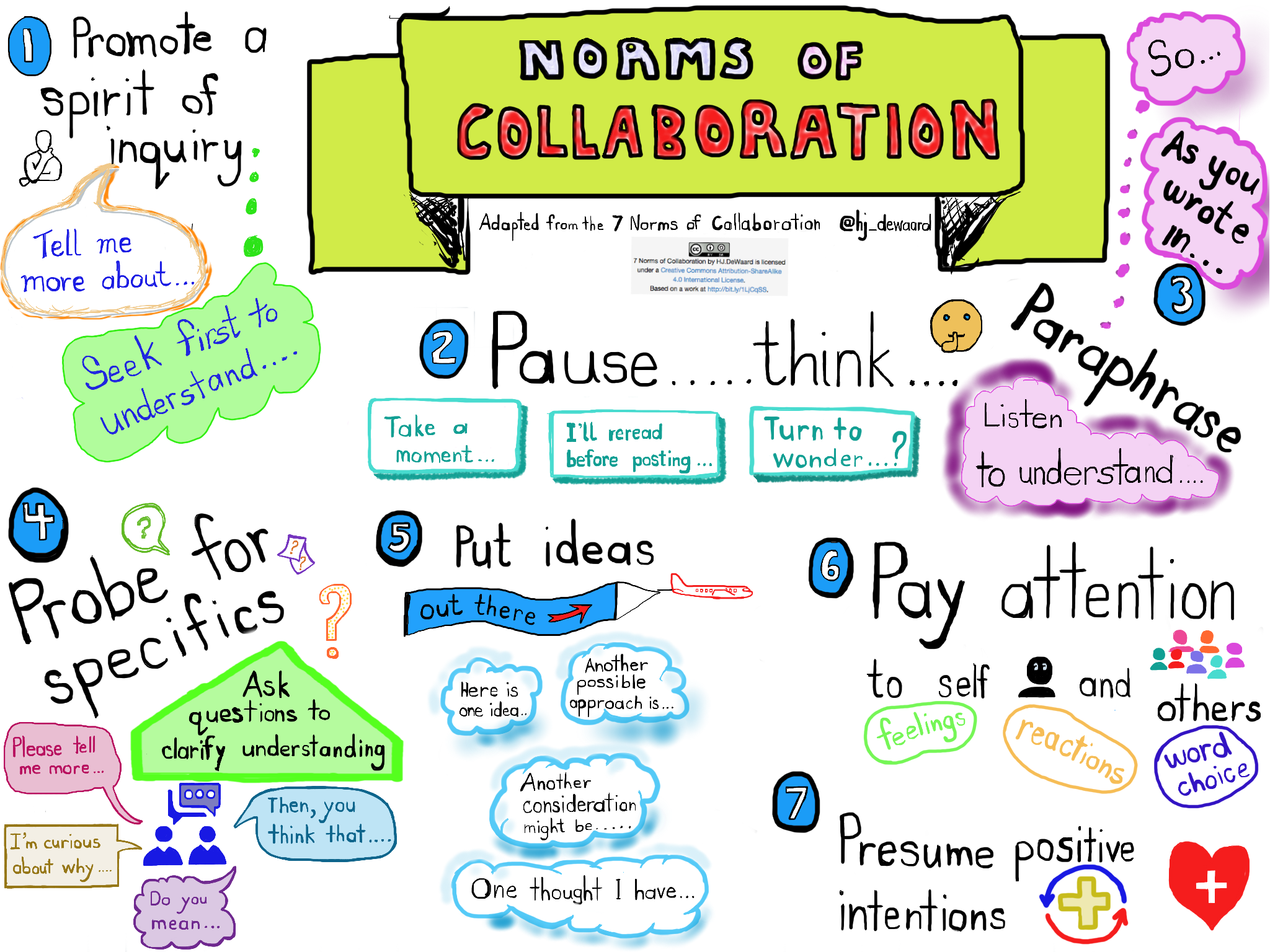Nearpod Virtual Learning
Using virtual reality, also known as VR, has really changed the ways of education. One amazing tool using virtual reality is called Nearpod. Augmented reality is sort of like virtual reality, however, VR is an immersive experience where AR augments your surroundings with digital elements. Nearpod uses both of these types of virtual wonders, which is what you will be reading about here!
Nearpod uses fieldtrips that can take the students everywhere, at anytime! The students never have to leave their seat or spend a bunch of money to experience all the opportunities that Nearpod allows them to access. Nearpod also allows the educator to add virtual reality photos, making it again a very immersive lesson for the student. There are thousands of photos to chose from giving the educator a wide range of ideas and “places to visit”. Students have access to these fieldtrips from any device, meaning they can even access it at home with a school login, but it does not need to be a school computer or tablet!
That being said Nearpod gives the students a personalized experience that they may never get to see in real life, students who are less fortunate can see places they may not be able to right now. It is an amazing tool for any educator regardless of the grade they teach!
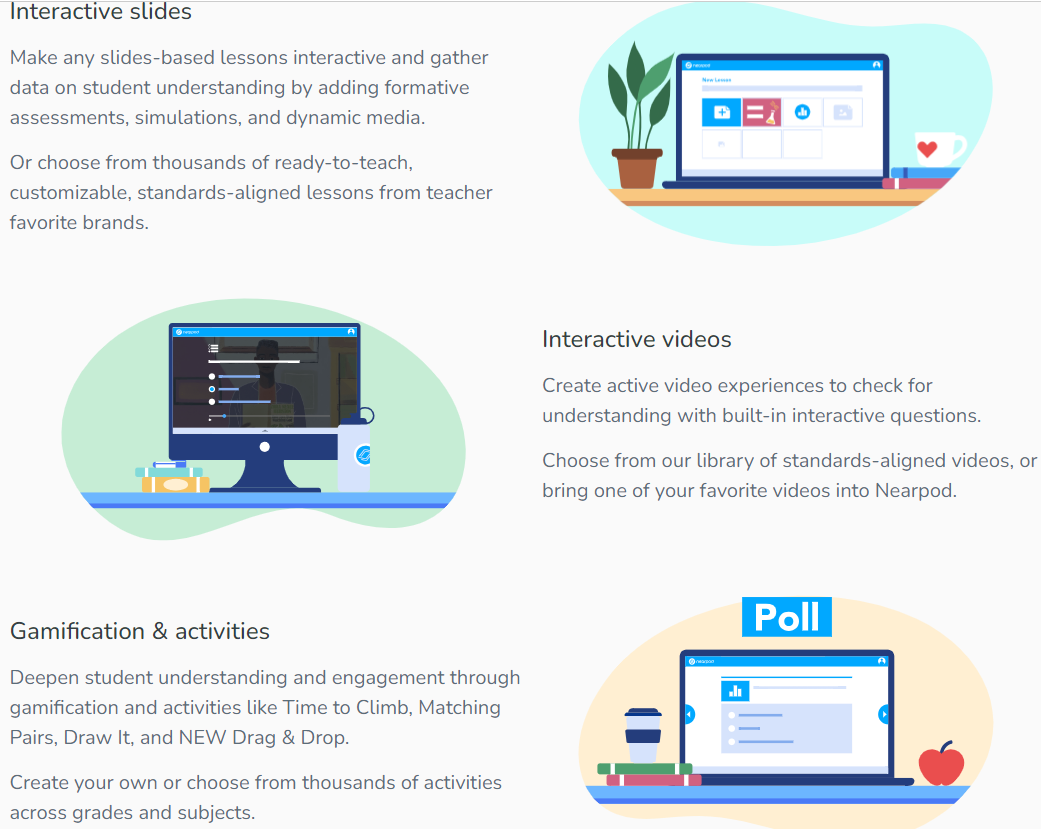
We Virtual Learning
we.org is an online learning tool, which teachers can find very useful. The virtual learning center is a place filled with tools for educators to use, ultimately enhancing their ways of teaching and helping to engage the minds of students even more. Teachers now can stay learning in a fun and creative way!
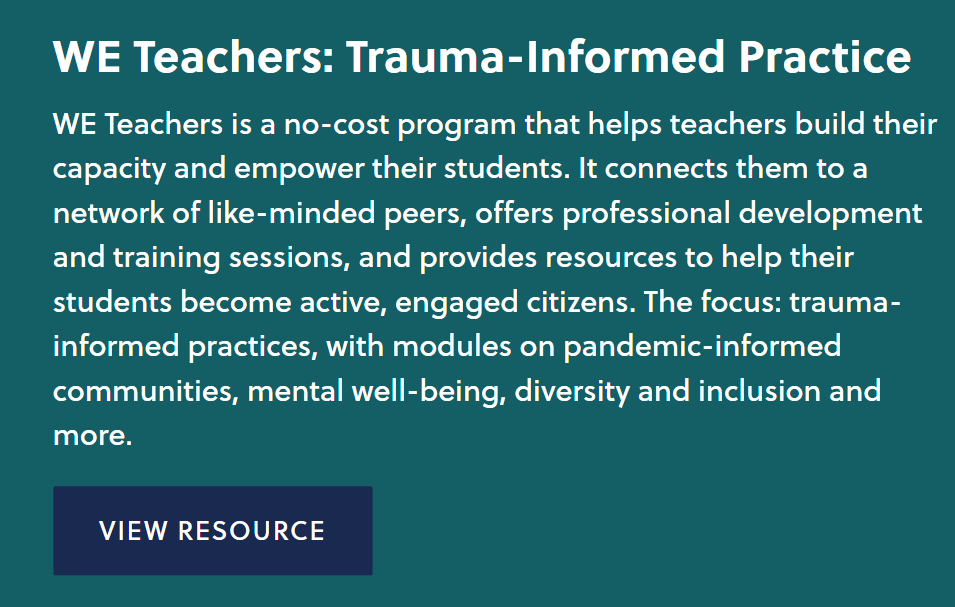
Above shows a small explanation of the teacher resources!
As someone who is going to be a teacher very soon I found this tool to be so amazing! The lessons are short, yet very informative, making this a easy way to be educated even with a busy schedule.
There a tons of options to chose from and most, or maybe even all, are suitable for every grade level that you teach. All of the resources are something that would be very helpful in a classroom, here is one of the examples and how they look!

There are also virtual workshops educators can join, again to teach them more information. The grade levels which it is suitable for are also posted near it.

Overall, I can not wait to use these tools to transform my future classroom, and to share these ideas with my future fellow coworkers to also expand their minds and ideas!
Seven Accessibility Tools
There are so many different tools to use for accessibility, making the web easier for people who need it. Here are just some of the many tools!
Easy Reader-Easy Reader is a tool which helps individuals with dyslexia, poor vision, or blindness navigate the internet in an easier way.

WritePad- WritePad is a feature that can turn your handwritten notes into a document, for easier storage and easy sharing!

inClass- inClass is such a helpful tool for organization, which many students struggle with. This way schedules, notes, video notes, audio notes, and even photo notes can be shared in one file to make it easy to find and organize.

Microsoft Office Lens- Microsoft always has the best tools! However, this one is amazing, as it allows students to add in photos of their class white boards and enhances, and allows students to add and edit text!

ListNote Speech-to-Text Note- Another great note taking tool that takes notes as you speak, then the notes are able to be easily found by keywords and filters.

Flora/Forest: Stay Focused: An environmentally friendly education tool that plants a tree when you stay focused on your work and do not use a cellphone. Which is a great way to encourage students to stay on task while helping out our planet, teachers should push this tool for their students!

Graphing Calculator by Mathlab: A great android tool! This way students who use androids can have access to a graphing calculator. It is made to help develop math skills, problem solving, and critical thinking.

Hyperdocs and using Edpuzzle
Hyperdocs are such an amazing tool, all educators should have in their back pocket. It is a interactive assignment for students, it gives students more of a personalized learning experience. Since they are able to go back and rewatch, answer questions while watching, and overall extends the learning of students. For example, edpuzzle stops students during the video to see if they know what they just watched, this is done in multiple choice or open ended questions. The picture below shows a video, and in the “To Complete” area it shows in the video there will be an open ended question to answer.
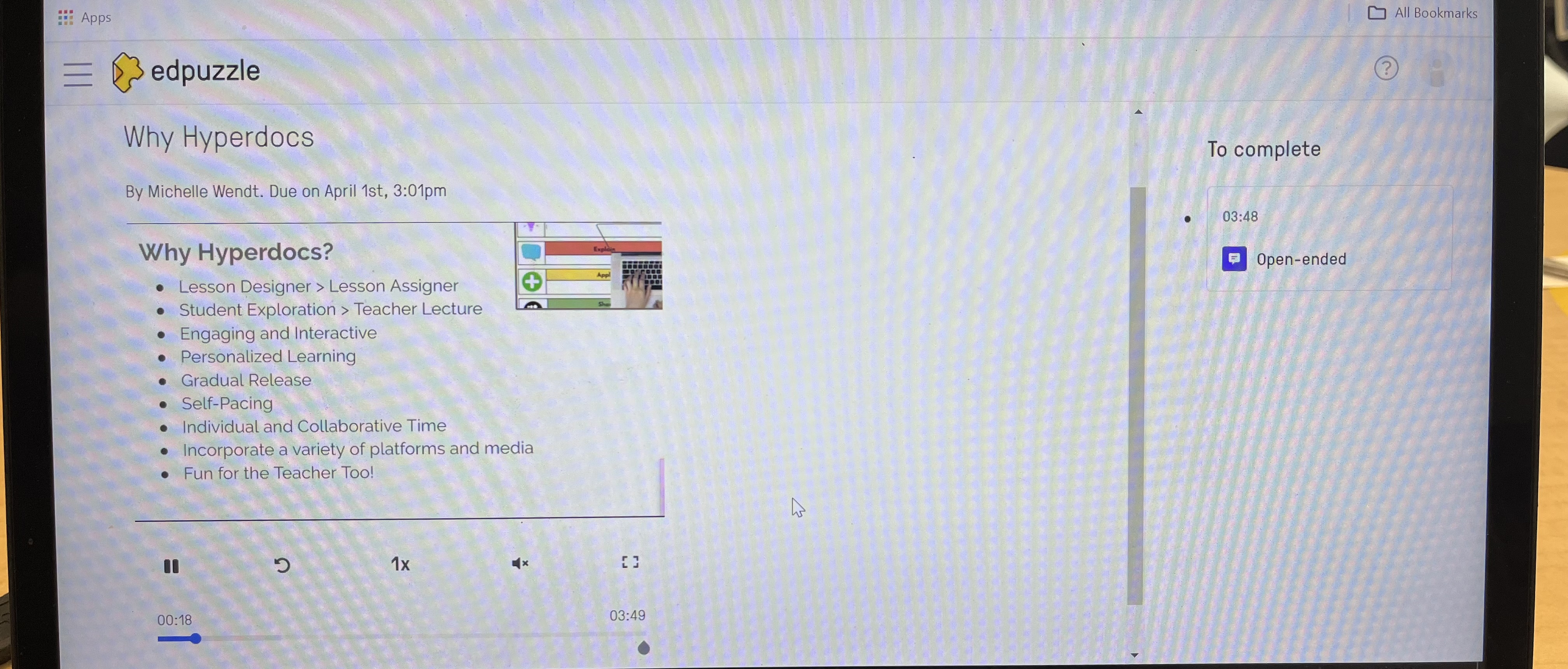
At the end of your assignment it also shows the student how they did, getting an immediate grade. Helping both the student and teacher out, teachers do not have to grade as much, and students if it is multiple choice gets a grade immediately. If it is open ended the teacher gets to go on and grade the student based on their response, which is another nice feature.
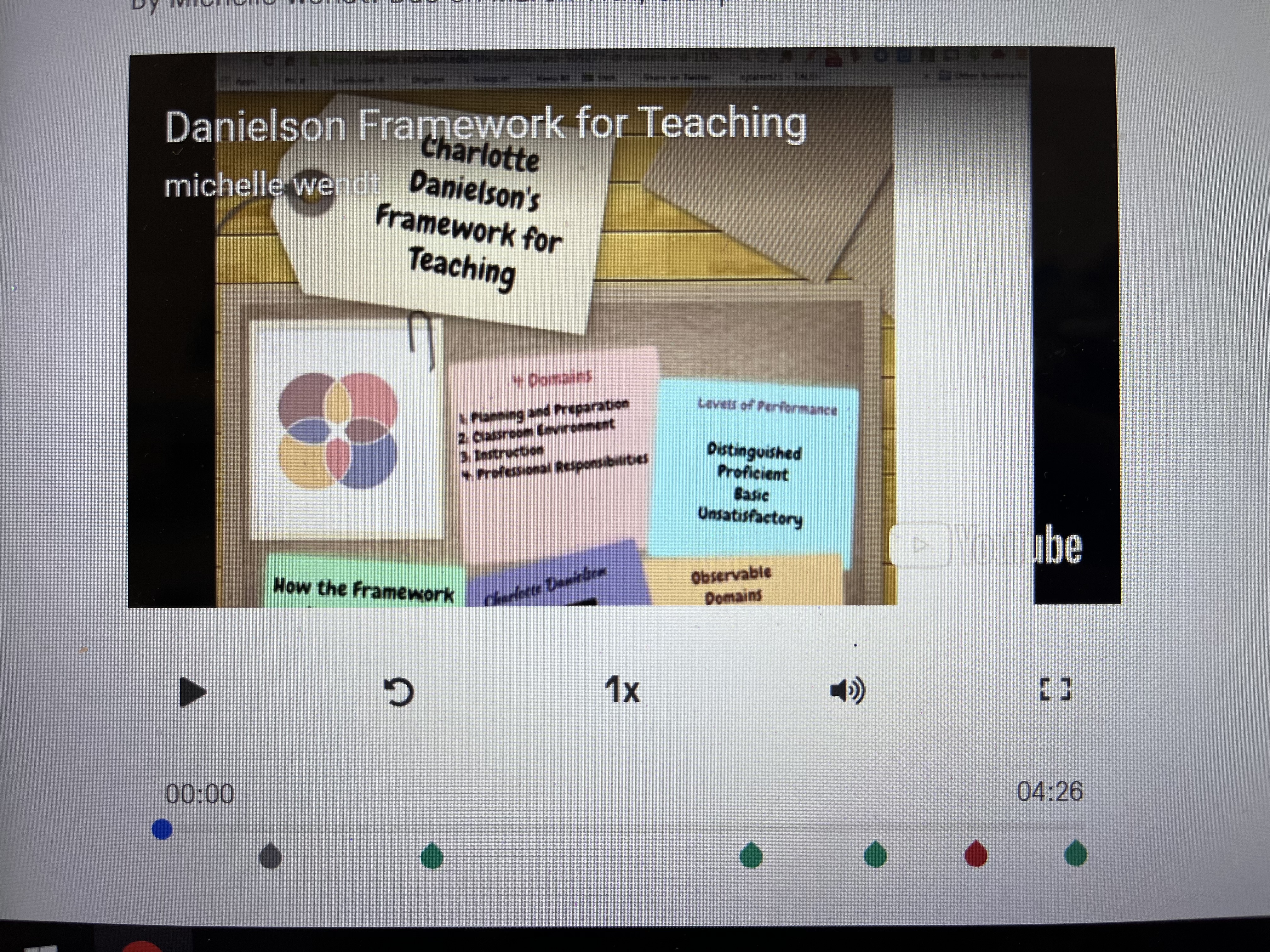
This picture shows where the questions in the video are located for this specific assignment. It also shows the colors green, gray, and red. Gray shows that one was a open ended and is not yet graded, green shows it is correct, and the red will tell the student what they got wrong in the assignment.
The Louvre
I chose a virtual tour of The Louvre. The online experience offers the opportunity for all to visit this amazing place full of history and art collections. The tour offers history about the museum, adding that it was once a palace for the kings of France. Now today, it holds about 10,000 years worth of history, making it the worlds largest museum. For the tour there are three different wings, Richelieu, Sully, and Denon. The wonderful Mona Lisa painting has been here since 2005, which is available to see through pictures on the tour. There are also many more paintings you can look through, also with the option to zoom, allowing people to see close details you may not even notice in person. You have the chance to see Greek sculptures, Egyptian Art, and so much more. This really does give such an amazing chance for people all over the world, regardless of financials, to get to see the beautiful artwork created over so much time!
The options of many paintings to view
The zoom option talked about above
Communication in Education
Having communication in your classroom helps your students grow so much! This week I read the “Communicators” section through Perusal’s Sail the 7 C’s. It is so important to create a safe space for your students, it will help them want to participate. Every child wants to be heard, some are just too nervous to raise their hand and share. Students want something they enjoy, that is a HUGE part in the willingness to participate. Using videos, articles, group work, and more can hook your students in, they will like learning this way, and it will help with comprehension. With the improvement in comprehension the student will feel safer to participate, knowing they have a full understanding of the material. Then, there is using games with an in-chat feature, which can help students who usually stay quiet want to talk in chat form. The students who may not talk out loud but want to be heard can use gaming chats to get out what they want to say! Educators can even use Microsoft to connect with their students, reports can now be sent out showing the student how they are doing on that task. Again, it is communication without being singled out or told in front of the class. This is a private progress report given by your teacher, which again can aid in the comfortability the student feels with their teacher. Finally, there is using Microsoft Forms to gather a “weekly review”, again done in a private form between the student and teacher. The teacher may ask questions such as how they would rate the week, how things can improve next week, the teacher can ask the student if they need any help, and what the best way to assist them is, there are so many questions and prompts you can add in these Forms. It is just another helpful way to form a relationship with their student and communicate with one another to better themselves!

Students and Global Goals
Do our students really know what is going on around in the world? Do they understand how us as a community can come together to change that negativity? A published article, Global Education Checklist, helps teachers and other school employees find out how to teach goals to students. The checklist provides what the children should know for each of the discussed goals. For example, it talks about the library. It asks educators if books involving global goals are available for students, are the books diverse talking about all different ethnicities, are items up to date, and more. This checklist helps so much for educators to make sure everything is in check to properly teach and include all children. There is a scale provided to help the educators rate how well the school does on a scale of 1-4 with the global education. There is a section asking about the textbooks provided, there is a state/institutional checklist, state standards and curriculum. This part is the section for state educators’ agencies. Overall, this is such an amazing checklist, that all educators should take a look at. The checklist goes for all K-12 students, all the schools should have this checklist gone over and each Indvidual teacher. For the future, in my classroom I will always be sure it fits all these requirements, it is so important to expose children of all ages to the global topic. Making sure to have an inclusive and safe environment for all of the future students I will have!
Collaboration In Education
Is it important to create office hours for students in the summer? Author and Principal, Dr. Bryan Pearlman takes this topic to “X”, and believes this is important in connecting and setting up a good foundation for the new school year. Dr. Pearlman argues that by him keeping his hours extended into summer he has help set a child up for the year, going from a “bad” student to a brand new version. The students mom went to the principal asking for him to meet her son early, without hesitating he said yes, even though she described her son as “the schools bad kid”. This did not stop Dr. Pearlman, he instead heard his favorite things and reassured this mom that he sounds like a “cool kid”. A little later, he met the student, and after just a short hello he noticed this kid knows how to make a good impression. After spending the day with him Dr. Pearlman knew exactly what to do, and he met up with this students new teacher for the year. Together they used Dr. Pearlman’s, “10 Minute Problem Solving”, which was created by him a few years back. After doing research, I figured out what the “10 Minute Problem Solving” method is, basically Pearlman suggests principals and educators sit down and come up with a plan that can be implemented that very day, which is awesome! Pearlman says, “The time and energy really pays off with reduced disruptive behaviors, improved outlook, and success in school and life.” which was found on Dr. Bryan Pearlman’s LinkedIn. This method paid off, because this student went from the “bad student” to being one of the best Pearlman ever saw in his career! By never collaborating with other educators people can miss out on this amazing strategy which can really change a students life. Without Pearlman offering these hour this student may still be stuck in his old ways, now he is a brand-new student!
Podcast: Play in new window | Download
Technology in Teaching
In the article I have read about creating videos for students in the classroom to learn from. The article is titled, “Four Tips for Creating Awesome Classroom Videos” on page 15, found in the link. The teacher from the article found a way to help all students at the same time, by using an online video created by him to help explain the topic more. The teacher we read about, John Stock, taught his coworkers and other educators about this neat way to help all of the students. Stock didn’t just use his videos to go over the lesson, or to teach, but to give out announcements as a way to connect with his students. By adding in these informational videos, it provided time for him to work one on one with the students who needed the extra attention. After his introduction to the topic and why they are important, we learn from Stock four amazing tips to help us educators see just how he made this possible. Stock starts off with telling us, “Just do it!”, instead of being nervous or worrying perfection it’s more important to just hop on the screen and try. Doing this benefits your students, they don’t need to see perfection all the time, just try and show them what you got! Second tip, be simple! Get right to the point in your videos, don’t overcomplicate or use big vocabulary, make it so everyone can understand. Stock also mentions QR codes as a nice easy way to get your video out there, instead of logging in, going through many different websites, have it easily accessible. Connect with your students, introduce yourself and don’t be overly closed off to students, you need to form a genuine connection. Finally, a big one to help nowadays, model famous social media personalities. Kids all the time now are on YouTube and social media, they like they videos usually because the person producing them or how they act in front of the camera. Model that, use funny lines, add in cool transitions, etc. the students want something they can relate to.
This image


